
Dorado is a constellation in the Southern Sky. It was named in the late 16th century and is now one of the 88 modern constellations. Its name refers to the mahi-mahi, which is known as dorado ("golden") in Spanish, although it has also been depicted as a swordfish. Dorado contains most of the Large Magellanic Cloud, the remainder being in the constellation Mensa. The South Ecliptic pole also lies within this constellation.

The Tarantula Nebula is a large H II region in the Large Magellanic Cloud (LMC), forming its south-east corner.
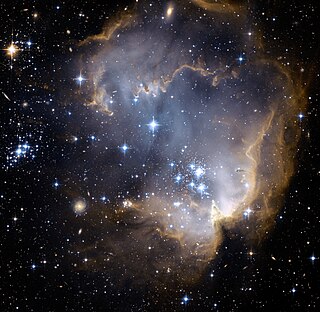
NGC 602 is a young, bright open cluster of stars located in the Small Magellanic Cloud (SMC), a satellite galaxy to the Milky Way. It is embedded in a nebula known as N90.
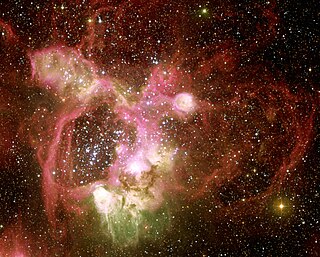
N44 is an emission nebula with superbubble structure located in the Large Magellanic Cloud, a satellite galaxy of the Milky Way in the constellation Dorado. Originally catalogued in Karl Henize's "Catalogue of H-alpha emission stars and nebulae in the Magellanic Clouds" of 1956, it is approximately 1,000 light-years wide and 160,000-170,000 light-years distant. N44 has a smaller bubble structure inside known as N44F. The superbubble structure of N44 itself is shaped by the radiation pressure of a 40-star group located near its center; the stars are blue-white, very luminous, and incredibly powerful. N44F has been shaped in a similar manner; it has a hot, massive central star with an unusually powerful stellar wind that moves at 7 million kilometers per hour. This is because it loses material at 100 million times the rate of the Sun, or approximately 1,000,000,000,000,000 tons per year. However, varying density in the N44 nebula has caused the formation of several dust pillars that may conceal star formation. This variable density is likely caused by previous supernovae in the vicinity of N44; many of the stars that have shaped it will eventually also end as supernovae. The past effects of supernovae are also confirmed by the fact that N44 emits x-rays.

NGC 1846 is a globular cluster containing hundreds of thousands of stars in the outer halo of the Large Magellanic Cloud. It was discovered on November 6, 1826, by James Dunlop and is included in the New General Catalogue. At an aperture of 50 arcseconds, its apparent V-band magnitude is 10.68, but at this wavelength, it has 0.07 magnitudes of interstellar extinction.

NGC 2035 is an emission nebula and a H II region in the Dorado constellation and part of the Large Magellanic Cloud. It was discovered by James Dunlop on August 3, 1826. Its apparent size is 3.0.

NGC 2029 is an emission nebula in the Dorado constellation and is part of the Large Magellanic Cloud. It is part of a complex of nebulae and stars, including NGC 2032, NGC 2035 and NGC 2040. It was discovered by James Dunlop on the 27 September 1826. Its apparent magnitude is 12.29, and its size is 2.25 arc minutes.

NGC 1871 is an open cluster associated with an emission nebula located in the Dorado constellation within the Large Magellanic Cloud. It was discovered by James Dunlop on November 5, 1826. Its apparent magnitude is 10.21, and its size is 2.0 arc minutes.

NGC 1873 is an open cluster associated with an emission nebula located in the Dorado constellation within the Large Magellanic Cloud. It was discovered by James Dunlop on September 24, 1826 and rediscovered by John Herschel on January 2, 1837. Its apparent magnitude is 10.4, and its size is 3.50 arc minutes.

NGC 1936 is an emission nebula which is part of the larger LMC-N44 nebula located in the Dorado constellation in the Large Magellanic Cloud. It was discovered by John Herschel in 1834 and added to the Catalogue of Nebulae and Clusters of Stars as NGC 1936. It was later observed by John Dunlop on September 27, 1936, and Williamina Fleming in 1901 and added to the Index Catalogue as IC 2127. Its apparent magnitude is 11.60.

NGC 1934 is an emission nebula located in the Dorado constellation and part of the Large Magellanic Cloud. It was discovered by John Herschel on November 23, 1834. Its apparent magnitude is 10.50.

NGC 1935 is an emission nebula which is part of the larger LMC-N44 nebula in the Dorado constellation. NGC 1935 is also located in the Large Magellanic Cloud. It was discovered by John Herschel in 1834 and added to the Catalogue of Nebulae and Clusters of Stars as NGC 1935, then was observed by Williamina Fleming in 1901 and later added to the Index Catalogue as IC 2126.
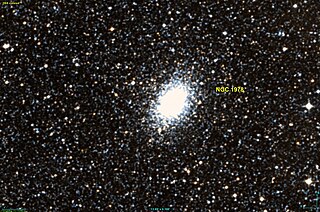
NGC 1978 is an elliptical shaped globular cluster or open cluster in the constellation Dorado. It is located within the Large Magellanic Cloud. It was discovered by James Dunlop on November 6, 1826. At an aperture of 50 arcseconds, its apparent V-band magnitude is 10.20, but at this wavelength, it has 0.16 magnitudes of interstellar extinction. It appears 3.9 arcminutes wide. NGC 1978 has a radial velocity of 293.1 ± 0.9 km/s.

NGC 2002 is an open cluster located in the Dorado constellation and is part of the Large Magellanic Cloud. It was discovered by James Dunlop on September 24, 1826. Its apparent magnitude is 10.1, and its size is 2.0 arc minutes.

NGC 1955 is an open cluster associated with an emission nebula located in the Dorado constellation. This nebula is part of the H II region which is part of the Large Magellanic Cloud and was discovered by James Dunlop on August 3, 1826. Its apparent magnitude is 9.0, and its size is 1.8 arc minutes.
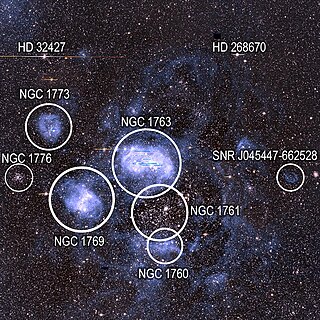
N11 is the brightest emission nebula in the north-west part of the Large Magellanic Cloud in the Dorado constellation. The N11 complex is the second largest H II region of that galaxy, the largest being the Tarantula Nebula. It covers an area approximately 6 arc minutes across. It has an elliptical shape and consists of a large bubble, generally clear interstellar area, surrounded by nine large nebulae. It was named by Karl Henize in 1956.
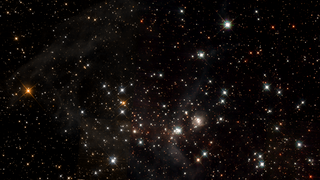
NGC 1974 is an open cluster associated with an emission nebula which is located in the Dorado constellation which is part of the Large Magellanic Cloud. It was discovered by James Dunlop on November 6, 1826, and later observed by John Herschel on January 2, 1837, subsequently cataloged as NGC 1991. Its apparent magnitude is 9.0 and its size is 1.7 arc minutes.

NGC 1983 is an open cluster associated with an emission nebula which is located in the Dorado constellation and part of the Large Magellanic Cloud. It was discovered by John Herschel on 11 November 1836. It has an apparent magnitude of 9.9 and its size is 1.0 arc minutes.
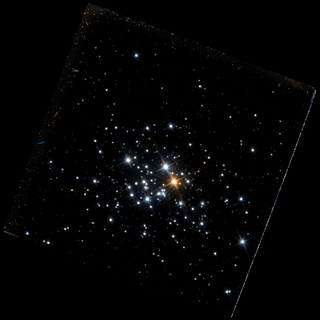
NGC 1984 is an open cluster associated with an emission nebula, it is located in the constellation Dorado in the Large Magellanic Cloud. It was discovered by John Herschel on 16 December 1835. The apparent magnitude is 9.9 and its size is 1.50 by 1.20 arc minutes.

NGC 1970 (also known as ESO 56-SC127) is a bright open cluster and emission nebula in the Dorado constellation in the Large Magellanic Cloud. It was discovered by John Herschel on January 31, 1835. Its apparent size is 8.0. It is commonly known as the Tulip Nebula.



















